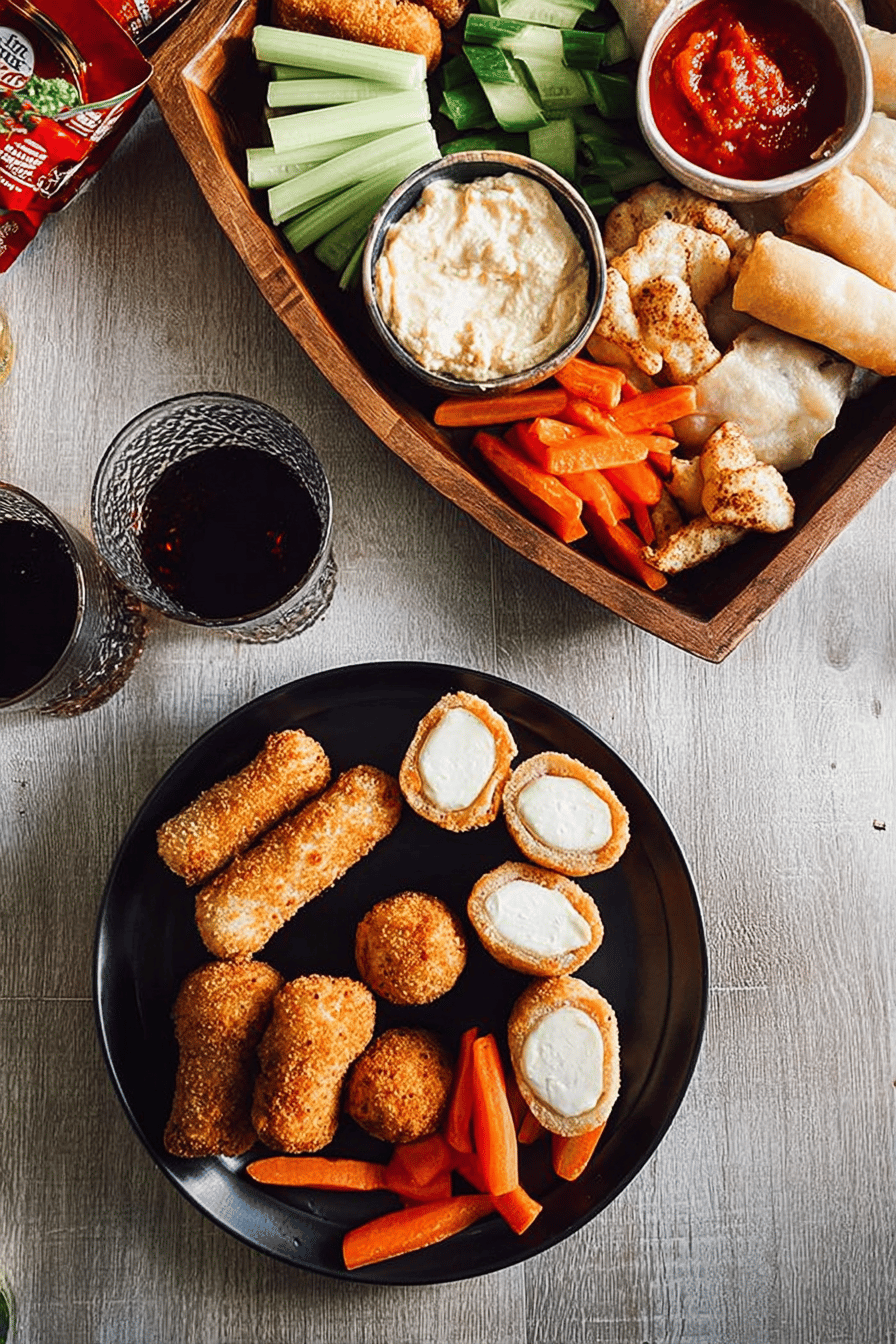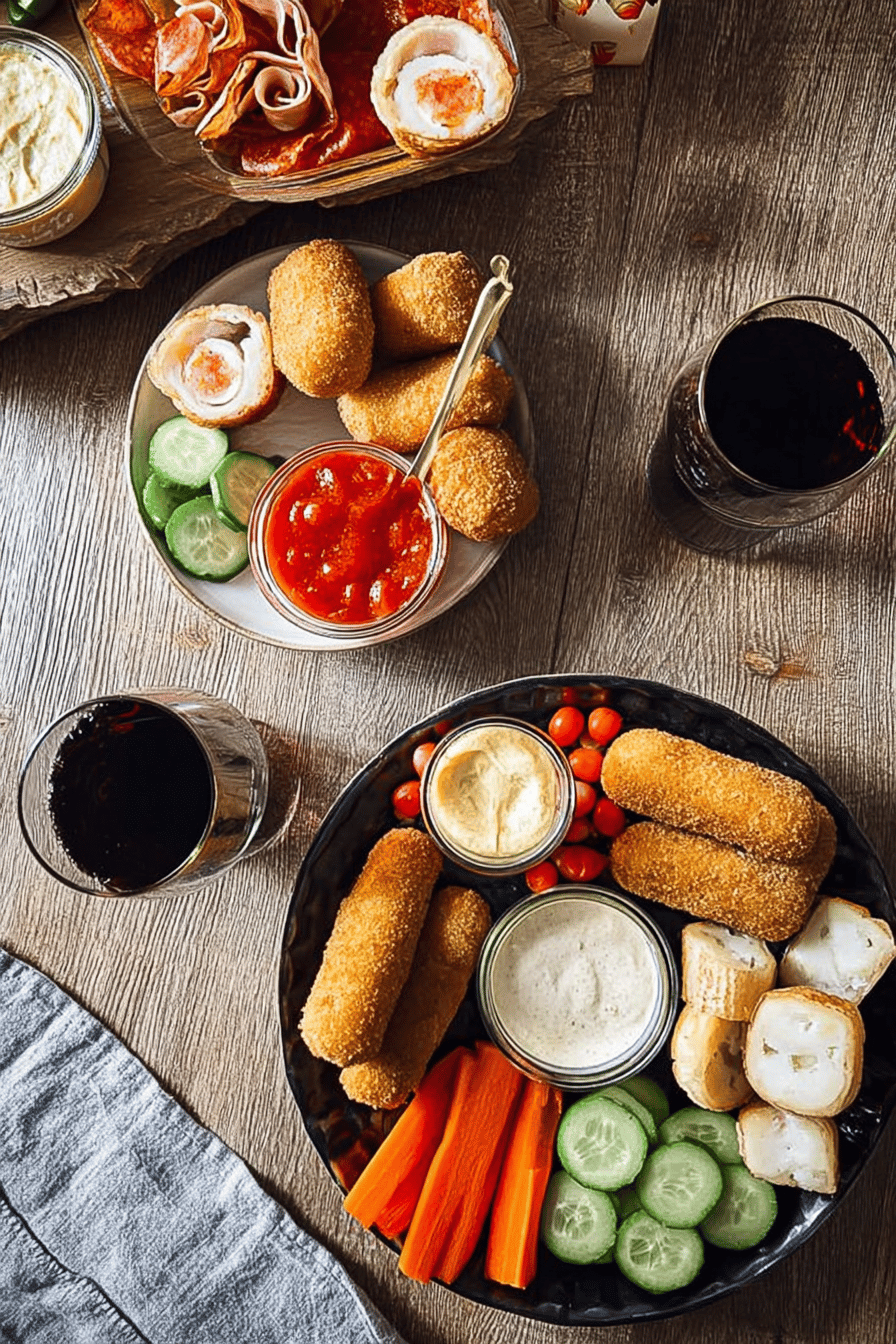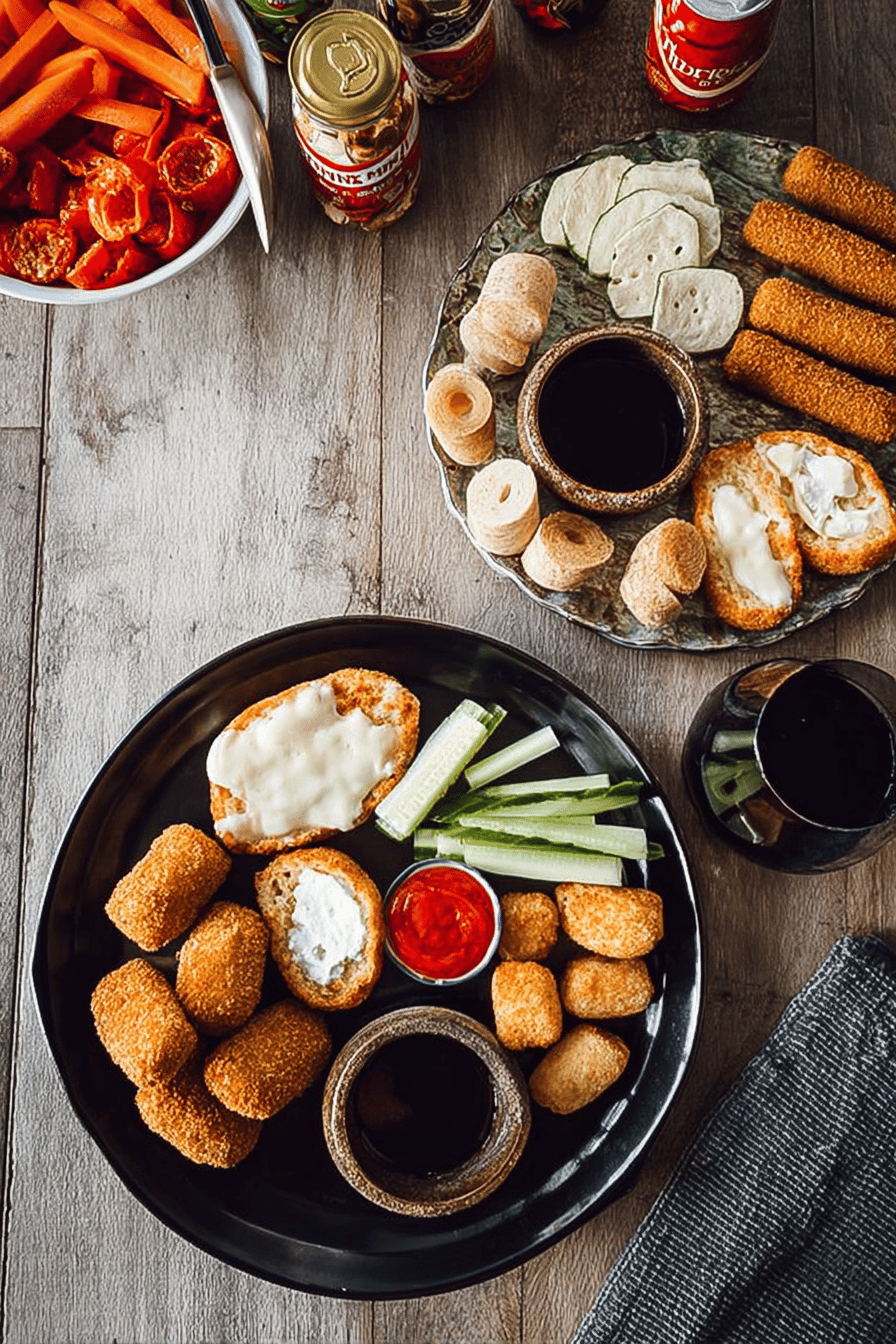Why You’ll Love This Snack Board
This snack board offers ease of preparation that makes it a go-to option for anyone short on time. With a simple assembly process and little cooking required, it’s ideal for busy days or impromptu gatherings with friends. You’ll enjoy how it delivers a balance of flavors and nutrients, making every bite both delicious and wholesome.
Health benefits come from the nutritious ingredients, supporting wellness with vitamins, minerals, and healthy fats that keep you energized. Its versatility allows customization for various dietary needs, whether you’re going vegan or gluten-free, so everyone at your table can find something they love. The distinctive flavor profile stands out with unique combinations that turn an ordinary snack into a memorable treat.
- Quick setup for stress-free entertaining
- Nutrient-packed options for better health
- Easy adaptations for all preferences
- Exciting tastes that impress guests
Jump To
- 1. Why You’ll Love This Snack Board
- 2. Essential Ingredients for Snack Board
- 3. How to Prepare the Perfect Snack Board: Step-by-Step Guide
- 4. Dietary Substitutions to Customize Your Snack Board
- 5. Mastering Snack Board: Advanced Tips and Variations
- 6. How to Store Snack Board: Best Practices
- 7. FAQs: Frequently Asked Questions About Snack Board
- 8. Snack Board
Essential Ingredients for Snack Board
Building a great snack board starts with selecting the right ingredients to create a balanced and appealing spread. We’ll cover the main items you need, along with ways to adapt for special diets. This ensures your board is not only tasty but also flexible for different tastes and needs.
Main Ingredients
- 1 cup mixed nuts (like almonds, pecans, pistachios, cashews, walnuts, and macadamia nuts) – for crunch and healthy fats
- 150g sliced cheese (including hard varieties such as manchego, cheddar, swiss, gouda, gruyere, and parmesan, plus soft ones like brie, triple cream, goat cheese, havarti, burrata, and cream cheese) – for protein and creamy texture
- 1 cup fresh fruit (assorted, such as grapes, apples, pears, oranges, raspberries, blueberries, blackberries, and strawberries) – for natural sweetness and vitamins
- 100g crackers (options include pita crackers, whole grain crackers, croccantini, toasted baguette slices, or mini toasts) – for a satisfying base, which can be gluten-free
- 1/2 cup hummus – as a plant-based dip for added flavor and protein
- Cured meats (such as prosciutto, salami, ham, chorizo, capricola, soppressata, and summer sausage) – no specific quantity provided, use as needed for savory bites
- Briny or pickled items (like olives, cocktail onions, cornichons, dill pickles, and pepperoncini) – add to taste for a tangy contrast
- Savory dips and spreads (such as whole ground mustard, tzatziki, romesco, and artichoke dips) – include in small portions for variety
- Fresh raw vegetables (like carrots and broccoli) – for crispness and extra nutrients
- Dried fruits (like apricots, cherries, figs, pineapple, and mango) – for sweet accents without quantities specified
- Sweet spreads (such as fig butter, orange marmalade, and blackberry jam) – apply as desired for flavor enhancement
- Dark chocolate pieces or chocolate-covered nuts – for a indulgent touch, amounts vary
Special Dietary Options
Whether you’re vegan or watching calories, you can swap ingredients to fit your preferences. For vegan choices, use plant-based cheese and dips like hummus. Gluten-free versions might include certified gluten-free crackers, and low-calorie tweaks could mean less nuts.
| Dietary Need | Suggested Changes |
|---|---|
| Vegan | Use plant-based cheese and vegan dips like hummus |
| Gluten-free | Opt for gluten-free crackers and certified gluten-free ingredients |
| Low-calorie | Choose light dips and reduce nut quantities |
For more ideas on complementary recipes, check out this pasta salad guide on our site to inspire your next meal.
How to Prepare the Perfect Snack Board: Step-by-Step Guide
Gathering all ingredients is the first step to ensure everything is fresh and ready. Begin by washing fresh produce thoroughly to keep things clean and safe. Then, slice cheeses and meats into bite-sized pieces for easy grabbing. Arranging crackers and nuts across the board next adds texture and sets the foundation for your layout.
Step-by-Step Instructions
- Gather all ingredients and wash fresh produce thoroughly to ensure cleanliness.
- Slice cheeses (from hard options like manchego and parmesan to soft ones like brie and goat cheese) and fruits into bite-sized pieces for easy serving.
- Arrange crackers and nuts (including almonds, pecans, and pistachios) evenly across the board to provide texture variety.
- Place dips like hummus, tzatziki, or romesco in small bowls strategically around the board.
- Add seasonal vegetables or alternative snacks, such as carrots, broccoli, or cured meats like prosciutto and salami, to diversify options and cater to dietary preferences.
- Garnish with fresh herbs or edible flowers for an appealing presentation and serve immediately or cover and refrigerate until serving time.
This method keeps your snack board balanced with sweet elements like grapes and strawberries, savory accompaniments such as olives and pickles, and even sweet spreads like fig butter. It’s a fun way to experiment, much like the simple recipes on our homepage where I share easy ideas for home cooks.
Remember, a well-arranged board not only tastes great but also draws people in with its colors and variety, just like the ones I prepare for casual get-togethers.
Dietary Substitutions to Customize Your Snack Board
Making swaps for protein and main components can suit different diets easily. For instance, use tofu or tempeh in place of cheese for vegan options, or pick vegan cheese varieties to keep it dairy-free. When it comes to gluten-free needs, certified gluten-free crackers or rice cakes work well as substitutes.
Ideas for Vegetables, Sauces, and Seasonings
Try adding seasonal vegetables like cherry tomatoes or cucumber slices to boost freshness. Swap traditional dips for flavored hummus or guacamole to add excitement. Adjust with herbs like basil or spices like smoked paprika to make flavors pop according to what your group enjoys.
- Protein alternatives: Plant-based options for inclusivity
- Veggie additions: Fresh picks like carrots for crunch
- Sauce variations: Hummus or mustard for extra taste
Mastering Snack Board: Advanced Tips and Variations
To take your snack board to the next level, try toasting nuts or spices lightly; this deepens their flavors without much effort. Experiment with combinations like a honey drizzle over cheese for sweet-savory balance, or add spicy pepper flakes for a kick. Presentation matters too, so use color blocking on the board to make it visually striking.
Pro Tips for Success
Opt for tiered serving trays if you have them, or group items by type for easy access. For make-ahead options, pre-cut ingredients and store them in airtight containers to save time, ensuring everything stays fresh. These techniques help create a board that’s not only delicious but also impressive for any occasion.
- Toast nuts for enhanced taste
- Mix flavors with honey or spices
- Use trays for better visuals
- Prep ahead for convenience
How to Store Snack Board: Best Practices
Proper storage keeps your snack board fresh and safe to eat. Refrigerate the assembled board covered with plastic wrap or in a sealed container, and aim to consume it within 24 hours. Freezing works for individual components like nuts or dips, but skip it for fresh fruits and crackers to avoid texture issues.
- Refrigerate covered items promptly
- Freeze only stable parts
- Avoid reheating most elements
- Meal prep by storing separately

FAQs: Frequently Asked Questions About Snack Board
What is a snack board and how do I make one?
A snack board is a visually appealing assortment of bite-sized foods arranged on a platter or board, perfect for parties or casual gatherings. To make one, choose a variety of items like cheeses, cured meats, crackers, fresh fruits, nuts, and dips. Focus on mixing textures, colors, and flavors for balance. Start by placing larger items and bowls first, then fill gaps with smaller snacks. Arrange foods in groups or clusters, and add fresh herbs or edible flowers for decoration. Snack boards are customizable to your taste and dietary needs, making them an easy and crowd-pleasing option.
What are some easy snacks to include on a beginner snack board?
For beginners, start with simple, readily available snacks like cheddar or mozzarella cheese, sliced salami or pepperoni, crackers, baby carrots, grapes, and mixed nuts. Include a small bowl of hummus or a flavored dip like ranch to add moisture and contrast. Avoid overly complicated ingredients or too many different flavors to keep the board approachable. This combination offers a good mix of sweet, salty, and savory items that are easy to prepare and popular with most guests.
How do I keep snacks fresh on a snack board for a long time?
To keep snacks fresh, prepare the board as close to serving time as possible. Store perishable items like cheese, deli meats, and cut fruits in the refrigerator until ready to serve. Use airtight containers for leftovers and avoid placing moist items directly on crackers to prevent sogginess—serve dips separately if possible. If you need to prepare ahead, cover the board with plastic wrap and refrigerate. Fresh fruits like grapes and berries should be washed and dried thoroughly before placing them on the board to maintain freshness.
Can I make a snack board suitable for dietary restrictions like gluten-free or vegan?
Yes, snack boards can easily accommodate dietary restrictions. For gluten-free options, use gluten-free crackers or substitute with vegetable sticks like cucumber, carrots, or bell peppers. For a vegan board, choose plant-based cheeses, hummus, nuts, olives, fresh fruits, and vegetables. Make sure to check labels for hidden animal products or gluten to avoid cross-contamination. Labeling sections on the board or providing separate boards for different diets can also help guests identify safe options clearly.
What occasions are best suited for serving a snack board?
Snack boards are versatile and suitable for many occasions such as casual get-togethers, game nights, wine tastings, picnics, holiday parties, or even office lunches. They work well as appetizers or light meals and encourage socializing as guests can graze at their own pace. Snack boards are especially popular for events where variety and presentation matter but you want a hassle-free food option that requires minimal serving effort and cleanup.

Snack Board
- Total Time: 15 minutes
- Yield: Serves a crowd
Description
🧀 Discover the art of creating a beautiful and diverse charcuterie board that’s perfect for any gathering.
🍇 Combining a variety of cheeses, meats, nuts, fruits, and dips, this guide makes entertaining effortless and impressive.
Ingredients
1 cup mixed nuts (like almonds, pecans, pistachios, cashews, walnuts, and macadamia nuts) for crunch and healthy fats
150g sliced cheese (including hard varieties such as manchego, cheddar, swiss, gouda, gruyere, and parmesan, plus soft ones like brie, triple cream, goat cheese, havarti, burrata, and cream cheese) for protein and creamy texture
1 cup fresh fruit (assorted, such as grapes, apples, pears, oranges, raspberries, blueberries, blackberries, and strawberries) for natural sweetness and vitamins
100g crackers (options include pita crackers, whole grain crackers, croccantini, toasted baguette slices, or mini toasts) for a satisfying base, which can be gluten-free
1/2 cup hummus as a plant-based dip for added flavor and protein
Cured meats (such as prosciutto, salami, ham, chorizo, capricola, soppressata, and summer sausage) use as needed for savory bites
Briny or pickled items (like olives, cocktail onions, cornichons, dill pickles, and pepperoncini) add to taste for a tangy contrast
Savory dips and spreads (such as whole ground mustard, tzatziki, romesco, and artichoke dips) include in small portions for variety
Fresh raw vegetables (like carrots and broccoli) for crispness and extra nutrients
Dried fruits (like apricots, cherries, figs, pineapple, and mango) for sweet accents
Sweet spreads (such as fig butter, orange marmalade, and blackberry jam) apply as desired for flavor enhancement
Dark chocolate pieces or chocolate-covered nuts for a indulgent touch, amounts vary
Instructions
1-Gather all ingredients: Gather all ingredients and wash fresh produce thoroughly to ensure cleanliness.
2-Slice cheeses and fruits: Slice cheeses (from hard options like manchego and parmesan to soft ones like brie and goat cheese) and fruits into bite-sized pieces for easy serving.
3-Arrange crackers and nuts: Arrange crackers and nuts (including almonds, pecans, and pistachios) evenly across the board to provide texture variety.
4-Place dips: Place dips like hummus, tzatziki, or romesco in small bowls strategically around the board.
5-Add seasonal vegetables or alternative snacks: Add seasonal vegetables or alternative snacks, such as carrots, broccoli, or cured meats like prosciutto and salami, to diversify options and cater to dietary preferences.
6-Garnish and serve: Garnish with fresh herbs or edible flowers for an appealing presentation and serve immediately or cover and refrigerate until serving time.
Notes
🧀 Use a variety of cheese textures and flavors to create balance and interest.
🍇 Include a mix of savory and sweet components to satisfy all palates.
🥖 Provide a selection of crackers and breads to complement the spreads and cheeses.
- Prep Time: 15 minutes
- Category: Appetizer
- Method: No-cook assembly
- Cuisine: Various
Keywords: Charcuterie Board, Cheese Board, Entertaining Guide, Appetizer Platter


